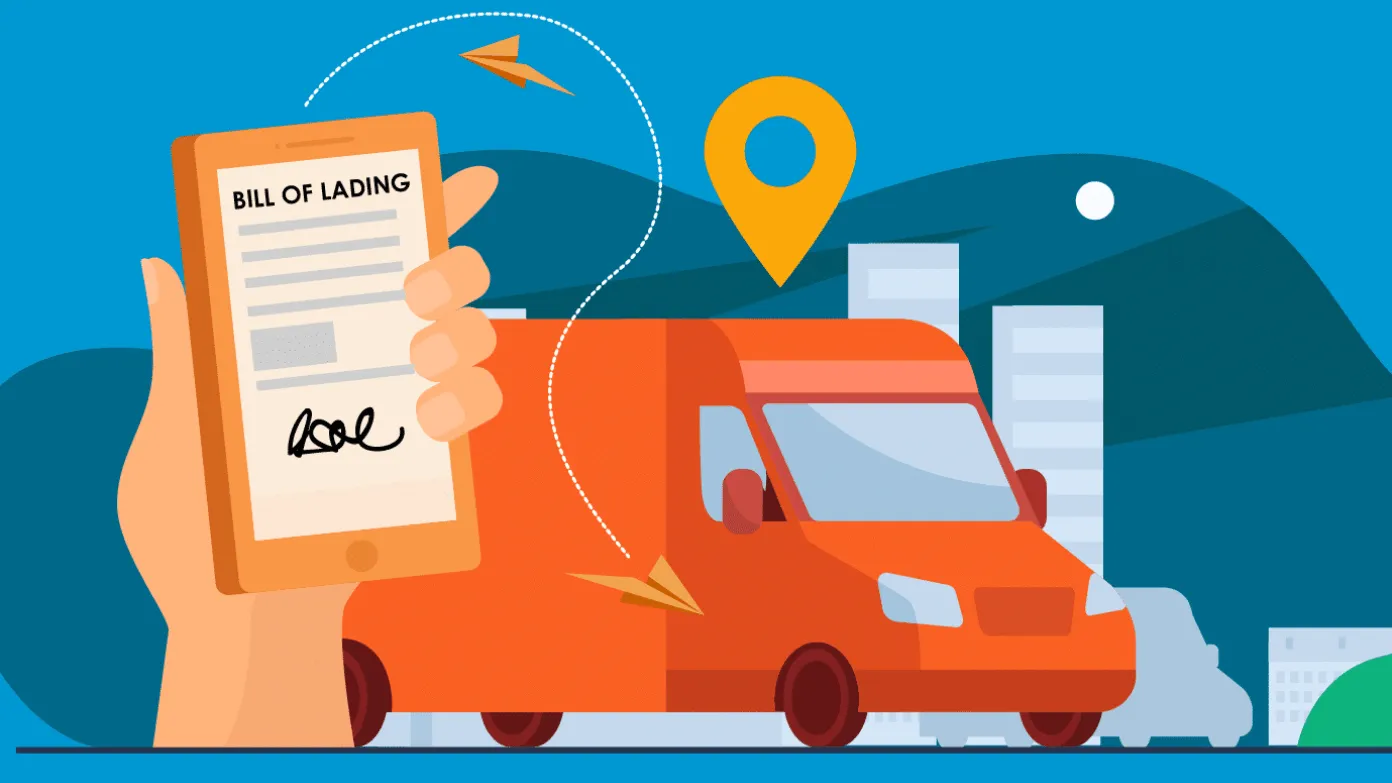From factories and vendors to the middlemen and last mile deliveries -- everyday billions of tonnes of raw materials or finished goods are ferried to and fro. If you are in the business of transporting cargo or need to supply or order goods in bulk (be it via trucks, flights, or ships) you would need to know your way around a bill of lading template aka the "transport document”.
In this article, you’ll find out about the many different bill of lading scenarios and how eSignature solutions such as Signeasy can help fast track freight processing. We have also created a generic, blank bill of lading (BOL) and a straight bill of lading template that you may download for free and customize as you deem fit.
What is bill of lading?
The bill of lading template is made up of two terms - ‘bill’ stands for the cost of goods delivered, while ‘lade’ is a nautical term that means ‘load cargo onboard’. Historically this document was used in relation to only carriage by sea, but now it also applies to goods transported by land and air. Therefore this bill is a legal contract that conclusively:
- Outlines or references the terms of the transportation contract (cost, quantity, final destination, conditions for transport etc)
- Based on the nemo dat rule, documents the ownership of the goods
- Acts as contract between a carrier and shipper, relating to the transportation of the goods
Note: There are three players who deal with the Bill of lading - the shipper (sends the goods), the carrier (transports the goods) and the receiver or consignee (receives the goods).
The bill of lading could be formulated for a prepaid or collect shipment.
For example, if a fabric business ‘ABC Ltd’ needs cotton to be shipped (collect) from a supplier in the next state. They share a PO with the supplier. The supplier in turn, contracts a trucking company (you!), and both their representatives sign the bill of lading after loading the cotton shipment onto the truck. Once the goods reach ABC Ltd., and are ready to be unloaded, its representative cross references the PO with the relevant bill of lading to ensure the right product was delivered before paying up for the same.
Typically, a bill of lading document is issued by the carrier to the shipper, and a copy should be attached to the packaged freight. It must also be signed by authorized representatives from the carrier, shipper and receiver. Along with the bill of lading an insurance policy and invoice are also sent across.
What's the purpose of the bill of lading template?
One of the most important documents in the freight shipping universe, is a fully completed bill of lading template because it:
- Acknowledges loading or delivery of goods (in good condition) by a particular carrier
- Safeguards against asset theft by serving as a document of title
- Helps in error-free invoicing
A bill of lading form is especially key for international trade shipments, as it provides all the critical details for exporters to conveniently process the shipment through different countries.
Fair warning : get this document wrong and you may face delays in shipment or even payment.
What to look for in a typical bill of lading template
Do you have a shipment to book? Then, check out our free template. In this bill of lading pdf, you will see the following details, which need to be entered by the shipper:
- Name and official address of the receiver and the shipper: These details should be legible and easy to locate on the bill of lading template.
- Purchase orders details or special reference numbers: Unique identifiers such as PRO number and bill of lading number will help shippers confirm whether to release the goods for pickup, while the consignee knows whether to accept it at delivery.
- Date of pickup: This is a reference used to track the shipment or cross-reference with shipping invoice
- Item description: Include the count, weight, Freight class (NMFC), dimensions of units being shipped. Also be sure to make note of the nature of the goods, whether the item is fragile, dangerous etc. This will help the carrier take special precautions, especially when shipping hazardous items.
- Packaging: Mention how the goods have been packages, eg: crates, palates, cartons, pills, drums etc.
- Special instructions: Here, add special notes for the carrier
*Disclaimer: The template offered up here is only for reference purposes. Be sure to check with local authorities and legal experts to confirm if this format will suffice for your shipment .
Types of bill of lading templates
Every shipper or exporter has a different way of transporting their goods. Accordingly, the bills of lading forms will also need to be tweaked. Here are examples of the most frequently used bill of lading types:
- Open bill of lading: Want to ship something overseas? Consider a negotiable bill of lading known as the Open bill of lading. Here, the consignee’s name can be changed, multiple times, with a signature - thus transferring the possession on the shipment.
- Bearer bill of lading: Are you looking to transport bulk shipments and release them in batches? Then, use the bear bill of lading. It mandates that whosoever has a copy of the bill of lading template receives the cargo. This means that initially, the consignee name doesn't need to be specified, or the column can be left blank.
- Straight bill of lading: Has your consignee paid for the goods before it was even shipped? Then, you use the non-negotiable straight bill of lading. Here, the carrier is required to deliver the shipment to one specific person and no one else. This is typically used for military purposes.
- Order bill of lading: Here is the most used bill of lading form in the world. This negotiable document lets transfer ownership of the goods to another party, if the consignee endorses this party as the ultimate consignee on the document. It is used when the freight is shipped before the payment is made. For example, when the carrier may transfer the title to the shipment to the importer, once it is delivered to the later, if endorsed by the exporter.
- Received-for-shipment & shipped bill of lading: This format is used when freight-forwarders (at a port or depot) need to share a bill with carriers or agents that confirms the merchandise has been received by the latter. But, remember, this does not make mention of whether the goods have been loaded into the carrier or not. This can be converted into a shipped bill of lading once the cargo is loaded on board. This new bill of lading will be an agreement between the carrier and the shipper.
- Clean or soiled bill of lading: If the shipper’s cargo has been loaded in good order and condition, the carrier may raise a clean bill of lading template. This will not carry any clauses that declare any damage to the goods and/or the packaging at the time of loading. In case the reverse is true, the carrier would issue a ‘soiled bill of lading’ or ‘dirty bill of lading’. This form will include a clause that highlights that the goods were “claused or dirty” along with remarks on the cargo’s condition. e.g. damaged packaging, broken cargo, missing pieces etc.
- Through bill of lading: This is the form to use if the shipping company needs to have complete authority to manage the transport of the cargo from source to destination. It covers the entire shipping process, with details of how the cross-border freight needs to be processed. And, usually it includes other bills such as negotiable ocean bills of lading (shipping overseas), non-negotiable air waybills (shipping via flights) and inland bills of lading (shipping by rail or road).
Combined transport bill of lading: Are you going to be combining shipping methods? Then use this bill. Also known as a multi-modal bill of lading, it will include details of cargo being transported via land and sea. For example, goods being transported from New York to Florida by trucks and then to India by ship.
Why choose an electronic bill of lading template?
Undeniably, we are in a world that is becoming increasingly contact-free. No one wants to touch pens, forms, scanners, printers or even exchange bills. This is why the idea of an electronic bill of lading template is growing in its appeal. You can download a blank bill of lading (BOL) form here.
Aside from the ‘hygiene’ factor, here are some of the top benefits of using an eSignature tool, such as Signeasy, to digitize, sign, send and track bill of lading forms.
- Cost-effective: Let’s face it, the paper that bills are printed on is quite costly. Not to mention the additional courier costs. On both counts, e-bills really help you save on costs.
- Speeds up paperwork: Unlike paper bills that take days to reach recipients and may even get lost in transit, electronic bills can be successfully sent in minutes across the globe. It's also stored on secure servers so you don't ever have to rummage through storage cabinets looking for the bills. This ensures that the shipping, transfer of ownership and accepting of delivery happens much faster.
- Modifies in a jiffy: No need to tear up paper bills every time someone makes an error. With e-bills, you can quickly make edits to the form and send it on with just a click on a button.
- Reduces form errors: Thanks to prompts offered by Signeasy’s ‘document fields’ feature, you can ensure that appropriate fields are filled and signed by the various parties.
Are you ready to e-sign your first bill of lading template with Signeasy? Just subscribe to our complimentary trial today!











